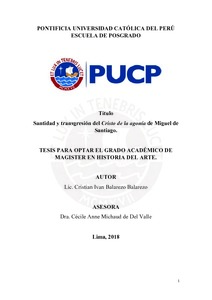| dc.contributor.advisor | Michaud Couzin, Cécile Anne | |
| dc.contributor.author | Balarezo Balarezo, Cristian Ivan | es_ES |
| dc.date.accessioned | 2018-08-10T18:24:33Z | es_ES |
| dc.date.available | 2018-08-10T18:24:33Z | es_ES |
| dc.date.created | 2018 | es_ES |
| dc.date.issued | 2018-08-10 | es_ES |
| dc.identifier.uri | http://hdl.handle.net/20.500.12404/12441 | |
| dc.description.abstract | El pintor quiteño, Miguel de Santiago (ca. 1630-1706), siendo especialista en
series pictóricas, emprendió un estudio anatómico artístico para representar a las imágenes
religiosas con un elevado nivel de realismo. Es así que pintó una serie de ocho pinturas
conmemorando la tradición de las Siete Palabras de Cristo. El carácter vanguardista de
esta serie elaborada en la Audiencia de Quito a mediados del siglo XVII, hizo que se las
asocie con una leyenda. Actualmente una de estas obras se encuentra en el Museo de los
Descalzos del Rímac en la ciudad de Lima, y constituye el objeto de estudio para la
presente tesis. Así que se emprendió una labor investigativa dentro de archivos,
bibliotecas, museos, entre otras estancias del Ecuador y Perú, con el fin de identificar la
procedencia, atribución, contexto y motivos de elaboración, conexión y variantes de la
leyenda, finalmente se analiza sus funciones y significados a lo largo de toda su existencia. | es_ES |
| dc.description.abstract | The quitenian painter Miguel de Santiago (ca. 1630-1706) had being a specialist
in pictorical series. He started an artistic and anatomic study in order to represent religius
images with a high realism level. Thus he painted a serie with eight paintings depicting
Christ’s Seven words on the cross. The avangardist pictorical serie made in the Audiencia
de Quito in the mid seventeenth century, was associated with a legend. Currently one of
these paintings is in the Descalzo´s Museum in Rímac district at Lima city. Therefore this
painting is the subjet to study in this thesis. The researching had taken place in archives,
libraries, museums and other locations in Ecuador and Peru. In order to indetify the
provenance, atribution, context and reasons for the creation, legend’s relations and
variants. Finally a survey of functions and meanings throughouth the painting’s existence. | es_ES |
| dc.description.uri | Tesis | es_ES |
| dc.language.iso | spa | es_ES |
| dc.publisher | Pontificia Universidad Católica del Perú | es_ES |
| dc.rights | info:eu-repo/semantics/closedAccess | es_ES |
| dc.subject | Santiago, Miguel de,-1706--Crítica e interpretación | es_ES |
| dc.subject | Pintura religiosa--Perú--Colonia | es_ES |
| dc.subject | Arte y religión--Perú--Colonia | es_ES |
| dc.subject | Arte y religión--Ecuador--Quito--Colonia | es_ES |
| dc.title | Santidad y transgresión del Cristo de la agonía de Miguel de Santiago | es_ES |
| dc.type | info:eu-repo/semantics/masterThesis | es_ES |
| thesis.degree.name | Maestro en Historia del Arte y Curaduría | es_ES |
| thesis.degree.level | Maestría | es_ES |
| thesis.degree.grantor | Pontificia Universidad Católica del Perú. Escuela de Posgrado | es_ES |
| thesis.degree.discipline | Historia del Arte y Curaduría | es_ES |
| renati.discipline | 222197 | es_ES |
| renati.level | https://purl.org/pe-repo/renati/level#maestro | es_ES |
| renati.type | http://purl.org/pe-repo/renati/type#tesis | es_ES |
| dc.publisher.country | PE | es_ES |
| dc.subject.ocde | https://purl.org/pe-repo/ocde/ford#6.04.02 | es_ES |





